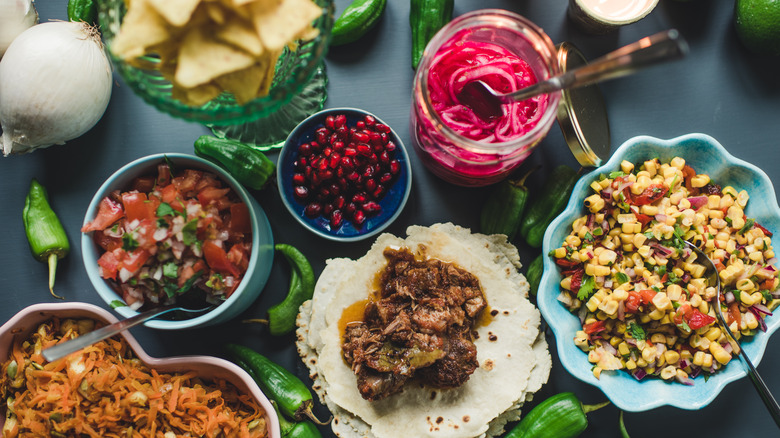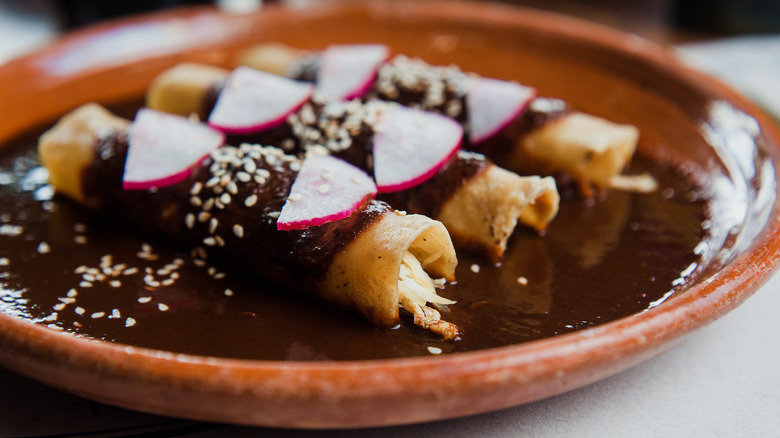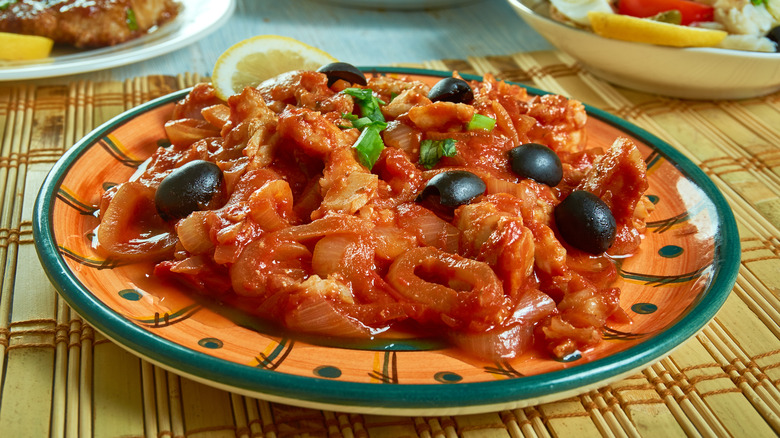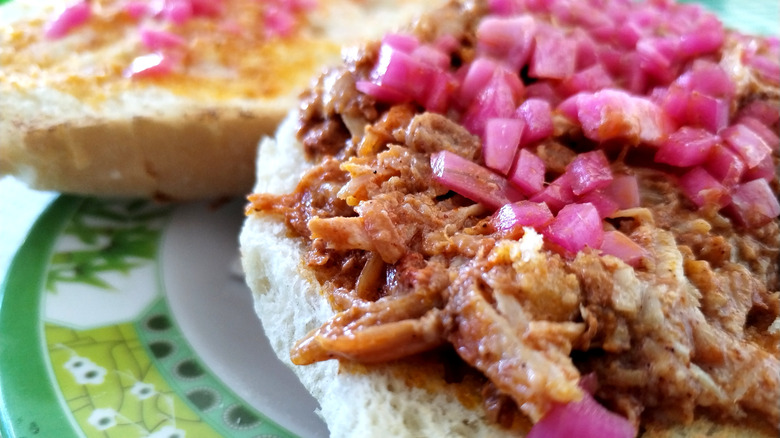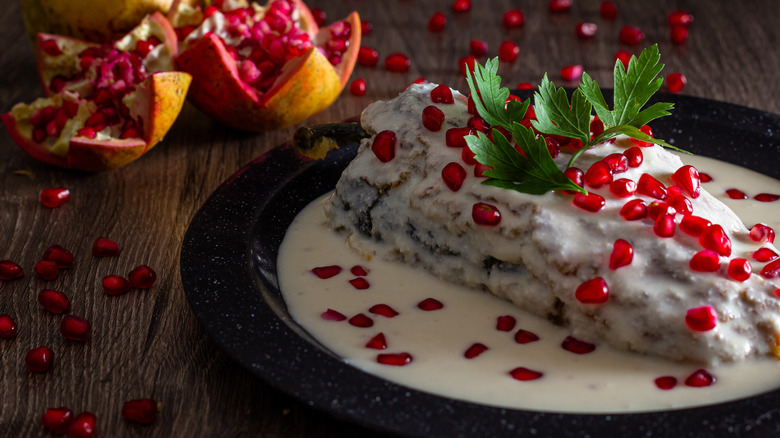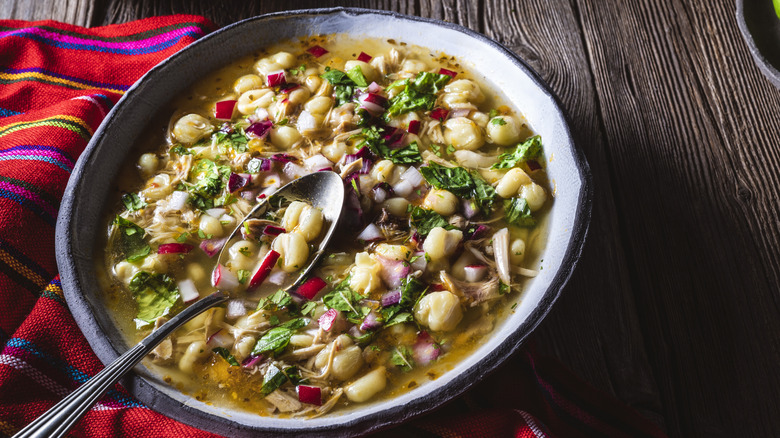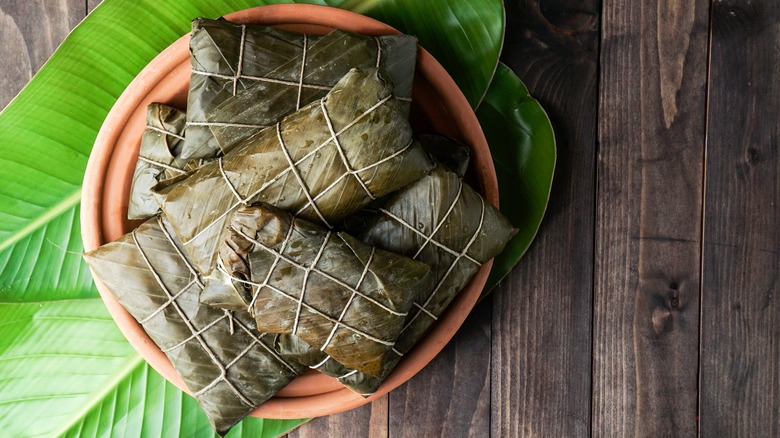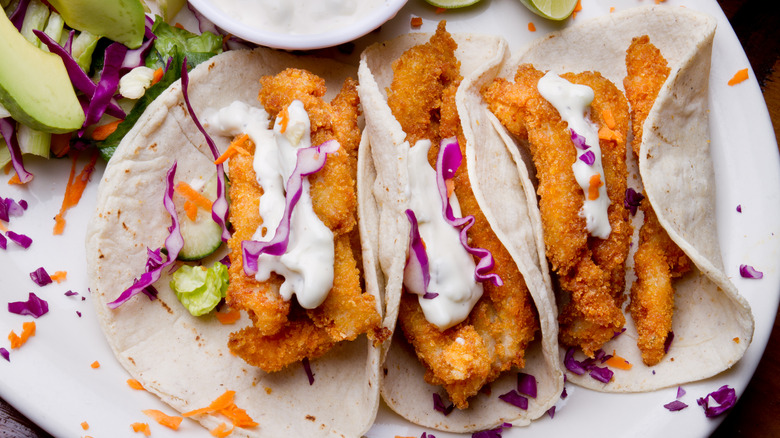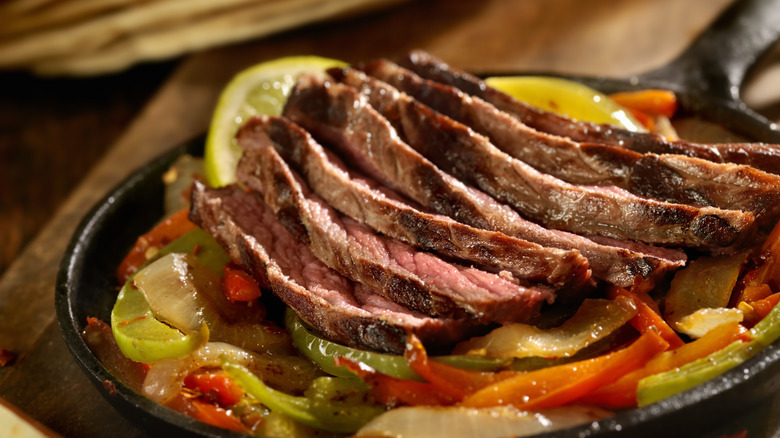A Guide To The Regional Cuisines Of Mexico
Mexican cuisine is way deeper and more complex than the items on your favorite combination plate may suggest. Even familiar favorites such as enchiladas and tamales have deep and ancient roots, with their earliest forms pre-dating European contact. For instance, the indigenous peoples of Mexico discovered the process of nixtamalization, or treating dried corn kernels with lime, which makes the resulting cornmeal both easier to work with and more nutritious. This ancient process, which has been practiced for millennia, is what gives corn tortillas and classic dishes like tamales their distinctive flavor and texture.
Mexican cuisine is also far more varied than you might expect. Mexico is a large and geographically varied country, and its inhabitants live everywhere from lush tropical environments to arid deserts and coastal regions. Each region has developed cuisines that celebrate what their local environments have to offer. In addition, Mexico has a rich history of immigration, and besides its indigenous peoples and the Spanish colonists, immigrants from countries including France, Lebanon, and China established themselves in Mexico and made their own contributions to Mexican cuisine. This means that an intrepid traveler may be able to experience local specialties virtually unheard of in other parts of Mexico. Here are some of Mexico's main regional cuisines and their signature dishes.
Oaxaca
If you want to experience Mexican cooking closest to its indigenous roots, you'll want to try the cuisine of the large, southwestern state Oaxaca. Oaxaca is distinguished by its large population of indigenous Mexicans — over half the state's population — most of whom live in isolated, rural villages, some nearly completely off the grid. While this is largely a result of institutional neglect by the Mexican government, it has meant that indigenous communities have been able to preserve their traditional foodways, from their recipes to cooking techniques and even ancient strains of produce, whose seeds have been passed down within these communities for generations.
Oaxacans are justifiably proud of their cuisine, which has drawn serious foodies to the region in recent years. The region is probably best known for its seven moles, complex sauces that include chiles, nuts, seeds, herbs, spices, vegetables such as tomatoes and onions, and additional flavorings such as chocolate. Even familiar Mexican staples take on different forms in Oaxaca. Tlayudas, for example, are giant, thin, toasted corn tortillas served topped with a rich, black-bean-and-pork-fat paste along with shredded cabbage, quesillo (Oaxacan string cheese), and cooked meats such as Oaxacan-style chorizo or chile-rubbed pork. Empanadas are made with fried corn dough rather than wheat and are often stuffed with squash blossoms. Wash your meal down with hot or cold chocolate (made from locally grown cocoa) or mezcal distilled from locally grown agave.
Veracruz
Tucked into Mexico's southeastern coast, the current-day state of Veracruz was where Spanish explorer Hernán Cortés first touched land in Mexico. This established the coastal city of Veracruz as a major throughway for Spanish settlers and traders. This is also why the regional cuisine of Veracruz shows its Spanish influence more clearly than the foods of other regions. For instance, whole snapper served a la Veracruzano — a classic local preparation — features a Spanish-influenced sauce of capers, garlic, olives, and tomatoes along with a distinctly local ingredient, pickled jalapeños. (Jalapeños, incidentally, were first cultivated in Xalapa, the state capital of Veracruz, and the word jalapeño translates as "from Xalapa.")
Because of its coastal location, seafood is used generously in the cooking of Veracruz, appearing in everything from tamales to hashes and even jalapeño peppers as a savory stuffing. In addition, its lush climate offers great growing conditions for tropical fruit, which are enjoyed fresh, in sweet and savory dishes, and in both alcoholic and non-alcoholic drinks. Another distinctive feature of Veracruzano cooking is its strong African influences contributed by enslaved West Africans who created now-iconic local specialties from peanuts, which are native to the region but previously not used by cooks. Among the African-influenced specialties of Veracruz are chicken with peanut sauce and salsa macha, a dried-chile salsa thickened with chopped peanuts.
Yucatán
Yucatán, which shares a border with Guatemala and Belize, is known for its vibrant, fresh-tasting cuisine that reflects the influences of the region's Spanish settlers and Mayan natives but also the influences of the region's immigrants and Caribbean neighbors. Defining flavors of the region include sour orange, whose tart juice is used to flavor marinades and pickles; achiote, a seed that's ground and added to dishes for its bright yellow color and slightly bitter flavor; and habañero peppers, which add fruitiness and heat.
Signature dishes include cochinita pibil, which is pork marinated in sour orange and achiote, wrapped in banana leaves, then slow cooked in an underground fire pit. Salbutes are soft, thick-fried corn tortillas with the topping of your choice. A dish with strong Mayan roots is papadzules, enchiladas topped with two sauces — a creamy sauce of ground pumpkin seeds and a bright tomato sauce. For a filling example of Yucatecan fusion cuisine, try queso relleno, which are hollowed-out and stuffed round shells of Dutch Edam cheese said to have historically been discarded from the kitchens of the wealthy, who only ate the soft interior of the cheese. Resourceful commoners stuffed these rinds with spiced pork, raisins, and nuts, heated them until melty, and served them with tomato sauce. Kibi is a Yucatecan take on Lebanese kibbe. The crusty meat croquettes are seasoned with sour orange and habañero, split in the middle, and loaded with cheese, chopped onion, shredded cabbage, and sometimes even more meat.
Puebla
A landlocked state between Oaxaca and Veracruz, Puebla historically served as a major crossroads on the trade route between coastal Veracruz and Mexico City. This not only made it a center for commercial, political, and cultural action, but also a fertile breeding ground for culinary innovation. Anything that made its way into Mexico made its way into Puebla, which meant that local cooks had access to not only the rich inventory of local ingredients such as chiles, corn, and nopales (cactus paddles), but also to ingredients from Africa, Europe, and Asia, as well.
A regional specialty exemplifying these influences is mole poblano, a sweet, complex sauce of chocolate, chiles, sesame seeds, cinnamon, allspice, and fruits such as plantains and raisins. Another classic, special-occasion dish of the region is chiles en nogada — cooked poblano chiles stuffed with a mixture of ground meat and minced fruits including apples and raisins, then topped with a creamy walnut sauce and garnished with bright red pomegranate seeds. The French Intervention of the 1860s brought French settlers to Puebla and a French-influenced baking culture along with them, and many of Mexico's signature breads, including conchas (snail-shaped sweet breads) and cemitas (brioche-like rolls), were first introduced in this region.
Jalisco
The culture of Jalisco is responsible for many of the most common items Americans associate with Mexico — mariachi bands and tequila originated in Jalisco, as did the distinctive Mexican cowboy culture that contributed to the region's hearty beef dishes. Guadalajara, Jalisco's largest city and a popular tourist destination, is surrounded by cattle ranches, and the region's food features not only a variety of saucy meat dishes (Jalisciense cooks love cooking with sauces) but also rich cheeses and custards courtesy of the area's many cattle.
Among the better-known specialties of Jalisco are posole, a soupy stew of meat and hominy that can contain chiles; torta ahogada, ("drowned sandwich"), a meat sandwich with pickled onions on a crusty roll dipped in a spicy, brothy tomato-chile sauce; and charro beans, which are soupy cowboy-style beans flavored with chile, garlic, onion, and meats such as chorizo or bacon. Seafood is also popular in the state's coastal and lakeside communities, and their seafood specialties include rollo del mar (rolled fish filets stuffed with minced shrimp and octopus, then sauced) and pescado zarandeado, or grilled fish. If you enjoy a cocktail with dinner, you won't want to miss Jalisco's famed tequila.
Chiapas
Chiapas, Mexico's southernmost state, offers a varied regional cuisine that proudly showcases its indigenous roots along with its Spanish influences. Local ingredients such as corn, beans, chickpeas, and wild herbs form the backbone of the region's cooking, while different areas of the state each boast their own specialties, which can range from cured meats to local cheeses and unique tamales with flavors indelibly associated with the cities or towns of their origin. Bright yellow, saffron-flavored tamales, for instance, are a specialty of San Cristóbal de las Casas, and the Mayan-influenced ball tamale, a round tamale made of two types of cornmeal and flavored with Simojovel chiles, is a specialty of the town of Simojovel de Allende. Popular all across the state are tamales filled with corn and chipilín, a wild herb commonly found in Chiapas.
Many of the region's favorite dishes are associated with holidays and religious observances. For instance, the Spanish-influenced sopa de pan (or bread soup) is a Holy Week specialty containing sweet bread, raisins, plantains, and green beans seasoned with spices including saffron and thyme. Cochita horneado, or baked whole pig, is another celebration dish traditionally served at the annual January fiesta of the city of Chiapa de Corzo. Chimbo is a convent sweet of bread pieces soaked in a syrup of honey, cinnamon, and anise, originally served in churches to keep the faithful going during long services. Today, the sweet treat is found and enjoyed throughout Chiapas.
Baja California
The cuisine of Baja California, the long peninsula just south of California, is a vibrant reflection of its sunny, seaside location and arid climate. Because the state is surrounded by water on both sides, seafood is bountiful in Baja California's cooking, and the state's cooks have a masterful touch for simple, memorable seafood preparations. A special point of pride, for example, is Puerto Nuevo–style lobster, which is simply split, cooked with butter, and served with beans, rice, and flour tortillas. The state's climate also nurtures wine grapes, and Baja California is also known for its wines. And, like the neighboring U.S. state of California, Baja California attracted Asian immigrants, who added their own spin to the local cuisine. Japanese immigrants in Tijuana introduced sushi, another popular way of enjoying the region's seafood, and in Mexicali cuisine, the long-established Chinese-Mexican community offers its own unique take on Chinese cooking.
Because of Baja California's proximity to the U.S. border, many of the region's dishes have become deeply entrenched in stateside dining culture. Fish tacos made with chunks of crispy batter-fried fish, for example, originated in Baja California, as did the Caesar salad, which was invented on the fly in the 1940s by a chef in Tijuana who was trying to replicate his mother's dressing recipe. Perhaps the region's most recognizable contribution to Mexican-American food culture is the margarita, which was invented in a restaurant in the seaside town of Ensenada in 1942.
Norteño
The arid, sandy land that characterizes much of northern Mexico also define its food. While you won't find the profusion of tropical fruit or produce common in wetter, lusher parts of the country, you certainly won't go hungry. Spanish settlers in the area discovered that while the land wasn't great for most crops, it was ideal for cattle grazing, and ranching became both a major industry and the heart of local food culture.
Northern Mexico is known for its hearty beef dishes, many of which were historically cooked outdoors. Among the local favorites are arrachera (marinated skirt steak) and cabrito (roasted baby goat). Another defining dish of the region is machaca, or dried, salted beef, which is commonly shredded and cooked with scrambled eggs or blended with other flavorings and rolled into burritos. The cultivation of wheat, rather than corn, dominates this region, and handmade flour tortillas — some as long as your arm — are another local point of pride.

